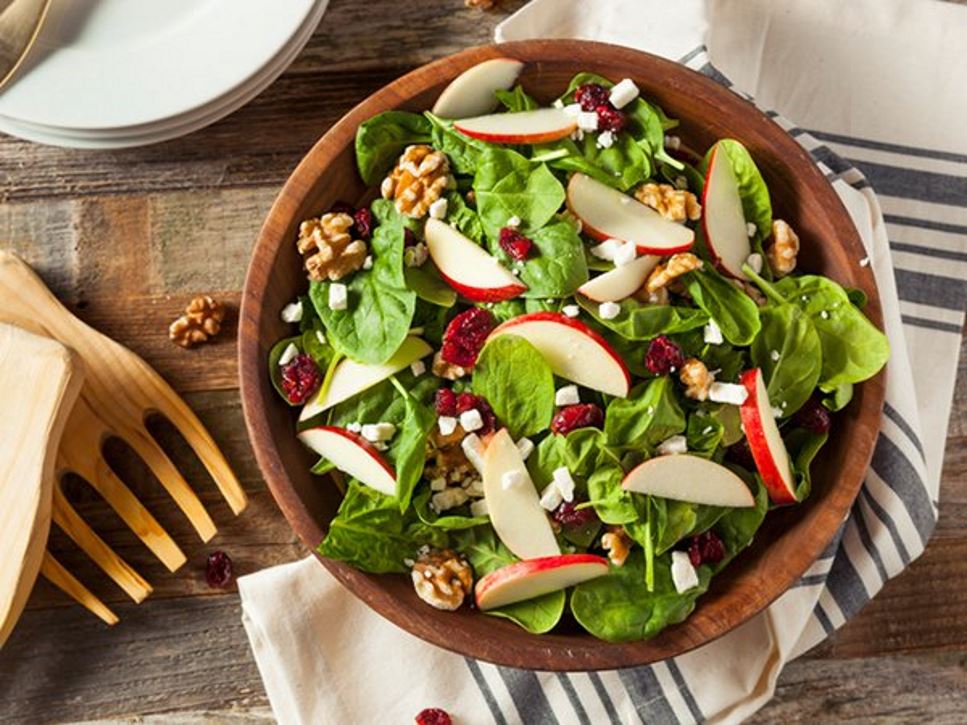What you sprinkle over your greens, as well as the amount, can make or break a salad. Here, we give you the scoop on a few unexpected toppings that will boost the flavor and nutrient content of your salad. Using small amounts and different combinations of ingredients can help add variety to salads.
Salads in Bloom
Your salad has greens, veggies, even fruits — so why not go further into the garden and add flowers too? Edible flowers, which include marigolds, violets, roses, nasturtiums, chive blossoms and pansies, can add color and flavor to salad. Just be sure to use flowers that are labeled as edible, like the ones you can find in the produce section at the grocery store. Other blooms, which are sold at nurseries and florists, may be toxic or grown with dangerous pesticides. Kitchen herb gardens also work well as a way to produce both flowers and plants for edible purposes.
Parsley, Sage, Rosemary and Thyme
Herbs, whether fresh or dried, are another way to add flavor to salads. Many supermarkets offer fresh herbs already packaged or as plants. Both fresh and dried herbs can be sprinkled on top as garnishes or used to make flavorful vinaigrettes or salad dressings. Try experimenting with different combinations, but start small and build flavor. If a recipe calls for dried herbs and you want to substitute with fresh, remember that 1 teaspoon of dried is equal to 1 tablespoon (3 teaspoons) of fresh snipped herbs.
Going Green
Avocados not only taste great, but also are a good source of heart-healthy monounsaturated fat and contain several vitamins and minerals, including vitamin E and potassium. They also provide dietary fiber, which most Americans don’t get enough of. Avocados are very versatile, too. For example, they can be chopped up and added as a salad ingredient or pureed into a dressing. It’s best to prepare them right before serving, because once an avocado is sliced, it will start to discolor. A little squeeze of lemon or lime juice can help prevent it from browning.
Texture You Can Sink Your Teeth Into
Nuts and seeds not only add interesting flavors to foods, but the crunch they provide can be just what a salad needs sometimes. Sprinkle on small amounts of nuts and seeds, such as walnuts, pecans, sunflower seeds, pumpkin seeds or even pine nuts. They provide unique flavors and textures when used as salad toppings.
Another ingredient that can make a salad more satisfying are beans. There are so many varieties to experiment with, but more common types used in salads include black beans, chickpeas (also known as garbanzo beans) and edamame. Cooked beans — whether they are purchased frozen, dried or canned — are all good options and a convenient way to get a plant-based source of lean protein.
Croutons typically get a bad rap, but if you make your own and use whole-grain breads, they can help you meet your daily goal for dietary fiber. Another option is to serve a scoop of cooked whole grains, such as quinoa or bulgur, over a mixture of salad greens. It's a great way to get the best of both food groups at one meal.
Looking for ways to get more calcium and vitamin D in your diet? A sprinkle of shredded cheese, such as mozzarella or Parmesan, or crumbled feta can add a lot of flavor with just a small amount. Plus, they are good sources of calcium. Eggs provide vitamin D and when hard boiled, make a great topping for salads.
A Touch of Sweetness
We all know that berries, apples, oranges and pears taste great on their own, but paired with salad greens, the combination of flavors can be extraordinary. Dried fruits, including cherries, cranberries, apricots or raisins, can liven up a salad and may be more convenient to use at certain times of the year. Plus, their flavor has been concentrated, so a smaller amount of dried fruit will provide the same intense flavor as its fresh, whole form.
Dressing It Up
Go for oil-based dressings, like vinaigrettes, more often than those made with ingredients such as mayonnaise. Oils, which are considered a healthier form of fat, are needed on a regular basis but only in small amounts. They provide important nutrients and help with the absorption of others, including vitamins A, D, E and K. Fats also help promote a feeling of fullness.
Variety is Key
Try experimenting with different recipes and an assortment of different colored vegetables to keep the salad combinations exciting and healthful. Being mindful of portions and choosing ingredients that pack a lot of flavor and texture in small amounts will also help. Plus, it will prevent your taste buds from becoming bored.
Find a Nutrition Expert
Looking for credible nutrition information and recommendations? The Academy of Nutrition and Dietetics' network of credentialed food and nutrition practitioners are ready to help!

